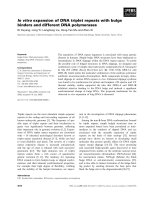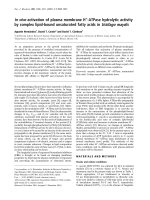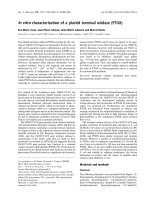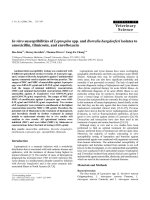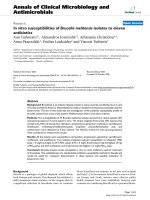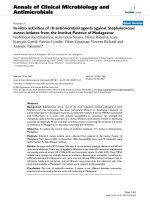Báo cáo y học: " In Vitro impairment of whole blood coagulation and platelet function by hypertonic saline hydroxyethyl starch" docx
Bạn đang xem bản rút gọn của tài liệu. Xem và tải ngay bản đầy đủ của tài liệu tại đây (1.38 MB, 8 trang )
ORIGINAL RESEARCH Open Access
In Vitro impairment of whole blood coagulation
and platelet function by hypertonic saline
hydroxyethyl starch
Alexander A Hanke
1*
, Stephanie Maschler
2
, Herbert Schöchl
3
, Felix Flöricke
1
, Klaus Görlinger
4
, Klaus Zanger
5
,
Peter Kienbaum
2
Abstract
Background: Hypertonic saline hydroxyethyl starch (HH) has bee n recommended for first line treatment of
hemorrhagic shock. Its effects on coagulation ar e unclear. We studied in vitro effects of HH dilution on whole
blood coagulation and platelet function. Furthermore 7.2% hypertonic saline, 6% hydroxyethylstarch (as ingredients
of HH), and 0.9% saline solution (as control) were tested in comparable dilutions to estimate specific component
effects of HH on coagulation.
Methods: The study was designed as experimental non-randomized comparative in vitro study. Following
institutional review board approval and informed consent blood samples were taken from 10 healthy volunteers
and diluted in vitro wi th either HH (HyperHaes
®
, Fresenius Kabi, Germany), hypertonic saline (HT, 7.2% NaCl),
hydroxyethylstarch (HS, HAES6%, Fresenius Kabi, Germany) or NaCl 0.9% (ISO) in a proportion of 5%, 10%, 20% and
40%. Coagulation was studied in whole blood by rotation thrombelastometry (ROTEM) after thromboplastin
activation without (ExTEM) and with inhibition of thrombocyte function by cytochalasin D (FibTEM), the latter was
performed to determine fibrin polymerisation alone. Values are expressed as maximal clot firmness (MCF, [mm])
and clotting time (CT, [s]). Platelet aggregation was determined by impedance aggregrometry (Multiplate) after
activation with thrombin receptor-activating peptide 6 (TRAP) and quantified by the area under the aggregation
curve (AUC [aggregation units (AU)/min]). Scanning electron microscopy was performed to evaluate HyperHaes
induced cell shape changes of thrombocytes.
Statistics: 2-way ANOVA for repeated measurements, Bonferroni post hoc test, p < 0.01.
Results: Dilution impaired whole blood coagulation and thrombocyte aggregation in all dilutions in a dose
dependent fashion. In contrast to dilution with ISO and HS, respectively, dilution with HH as well as HT almost
abolished coagulation (MCF
ExTEM
from 57.3 ± 4.9 mm (native) to 1.7 ± 2.2 mm (HH 40% dilution; p < 0.0001) and
to 6.6 ± 3.4 mm (HT 40% dilution; p < 0.0001) and thrombocyte aggregation (AUC from 1067 ± 234 AU/mm
(native) to 14.5 ± 12.5 AU/mm (HH 40% dilution; p < 0.0001) and to 20.4 ± 10.4 AU/min (HT 40% dilution; p <
0.0001) without differences between HH and HT (MCF: p = 0.452; AUC: p = 0.449).
Conclusions: HH impairs platelet function during in vitro dilution already at 5% dilution. Impairment of whole
blood coagulation is significant after 10% dilution or more. This effect can be pinpointed to the platelet function
impairing hypertonic saline component and to a lesser extend to fibrin polymerization inhibition by the colloid
component or dilution effects.
Accordingly, repeated administration and overdosage should be avoided.
* Correspondence:
1
Department of Anaesthesiology and Intensive Care Medicine, Hannover
Medical School, Germany
Full list of author information is available at the end of the article
Hanke et al. Scandinavian Journal of Trauma, Resuscitation and Emergency Medicine 2011, 19:12
/>© 2011 Hanke et al; licensee BioMed Central Ltd. This is an Open Access article distributed under the terms of the Creative Commons
Attribution License ( whi ch permits unrestricted use, distribution, and reproduction in
any medium, provided the original work is properly cited.
Background
Normovolemia and sufficient coagulation capacity are
major goals during early resuscitation of traumatized
patients with hemorrhagic shock. Nevertheless, s ignifi-
cant morbidity and mortality are related to coagulopathy
due to loss and consumptio n of coagulation factors as
well as volume substitu tion induced hemodilution. After
patient admission to the emergency care department
definite strategies have been established to improve out-
come after severe hemorrhagic shock [1] including
transfusion of packed red blood cell concentrates, fresh
frozen plasma, c ryoprecipitate and coagulation factor
concentrates. However, during the pre hospital period
various crystalloids and colloids have been suggested for
treatment of hemorrhagic shock. Whatever fluid is
administered, there is at least a dose dependent dilution
of coagulation factors which is associated with a further
impairment of coagulation.
Recently, small volume resuscitation b y intravenous
administration of small amounts of hypertonic saline
hydroxyethyl starch has been introduced for rapid
restoration of normovolemia following severe t rauma.
However, both hypertonic sodium chloride as well as
hydroxyethyl starch, impair coagulation and platelet
function; the former by altering plasma clotting times
and platelet aggregation [2], the latter by decreasing
FVIII plasma c oncentration and by interference with
fibrin polymerization and thus decreasing clot strength
[3-6]. Nevertheless, in a porcine model of hemorrhagic
shock and resuscitation, in general, the least effects on
coagulation were observed following small volume
resuscitation by administration of hypertonic saline
hydroxyethyl starch for resuscitation [7]. Since small
volume resuscitation was associated with alterations in
the coagulation system in this animal model as well, we
evaluated these complex effects on coagulation and
thrombocyte function in vitro in human whole blood
and tested the hypothesis that HyperHaes causes
impaired whole blood coagulation and platelet function.
Methods
The study was designed as experimental non-rando-
mized comparative in vitro study.
Following institutional review board approval (study
number: 2953, University Hospital Düsseldorf) this
study was conducted in accordance with the Helsinki
Declarations and European Unions Convention on
Human Rights and Biomedicine.
The guidelines fo r reporting non-randomized studies
[8] were utilized in the drafting of this report.
Blood samples
Ten volunteers (six male/four female; average age
33.7 years (range: 26-42 y)) of Caucasian origin participated
in the study after oral and written information and writ-
ten consent. All volunteers were healthy and free of med-
ication. Blood was taken from a basilic vein using an 18-
gauge IV catheter and collected in both citrated and
heparinzed tubes (Vacutainer, Becton Dickenson, Heidel-
berg, Germany).
Sample preparation
Blood was assigned to four different groups: Group A
(HH): Hypertonic Saline Hydroxyethyl Starch (Hyper-
Haes
®
, Fresenius Kabi, Bad Homburg, Germany); Group
B (HT): 7.2% hypertonic sodium chloride solution;
Group C (HS): 6% hydroxyethyl starch (HAES 200/0.5
6%,FreseniusKabi,BadHomburg,Germany);GroupD
(ISO): isotonic sodium chloride solution, serving as con-
trol group.
Blood samples were diluted with one of the four fluids
(HH, HT, HS and ISO) in a fix proportion of 1:20 (5%
dilution), 1:10 (10% dilution), 1:5 (20% dilution), 1:2.5
(40% dilution) and the effects of dilution were compared
to undiluted baseline values.
Whole blood coagulation
Whole blood coagulation was analyzed by rotation
thrombelastometry (ROTEM, TEM international,
Munich, Germany) in citrated whole blood samples. The
technique has been described previously elsewhere
[9-11]. In brief, ROTEM analyzes viscoelastic clot char-
acteristics over time in activated whole blood and recog-
nizes both the time course of clotting as well as the
firmness of the resulting clot. The following commer-
cially available tests were performed following the man-
ufacturer’s instructions: ExTEM (extrinsically activation
by tissue factor) and FibTEM (extrinsically activation by
tissue f actor with addition of Cytochalasin D to inhibit
platelet function and display fibrin polymerization only -
all tests Pentapharm, Munich, Germany). Since maxi-
mum clot firmness (MCF) in whole blood coagulation is
mainly determined by platelet function and fibrin poly-
merization, while clotting times (CT) are dependent on
the speed of thrombin generation by clotting factors
[10] the chosen parameters were: CT quantifying the
time from beginning of the reaction until start of clot
formation and MCF indicating clot stability at its high-
est degree.
Since samples for thrombelastometry are recom-
mended to be analysed within two hours we used three
ROTEM d evices in parallel. Tests were performed in a
standard sequence. ROTEM devices were chosen in a
random order.
Platelet function
Platelet function was determined by multiple elect rode
aggregometry (MEA) using a novel multiple platelet
Hanke et al. Scandinavian Journal of Trauma, Resuscitation and Emergency Medicine 2011, 19:12
/>Page 2 of 8
function analyzer (Multiplate, Dynabyte, M unich,
Germany, heparinized whole blood samples) following
TRAP activation (thrombin activating peptide, TRAP-
test, Dynabyte, Munich, Germany). The technique has
been described previously e lsewhere [11]. MEA utilizes
single uses test cells. These cells contain two pairs of
sensor wires extending int o a 50% diluted whole blood
sample. Platelets are non adhaesive in resting state, but
when activated stick to the sens or wires enhancing elec-
trical impedance between wires. These impedanc e
changes are recorded over a period of six minutes. Tests
were performed regarding the manufacturer’ sinstruc-
tions. As indicator for platelet function the area under
the aggregation curve (AUC) was determined indicating
overall platelet activity.
Electron microscopy
Scanning electron microscopy (SEM) was performed at
1:2000 and 1:5400 magnification on samples to e valuate
effects of HyperHaes on the cell shape of the thrombo-
cytes, using a Jeol 35 CF SEM and documentation by
Orion 6.60 software (Orion Microscopy, Belgium).
Statistical analysis
A power analysis was performed based on results of a
previously performed pilot test. Assuming an alpha
error of 0.05 with a power of 0.95 we calculated a neces-
sary sample size of 8 to show a significant effect of a
10% dil ution of HH o n MCF in the EXTEM test. Based
on this calculation and to ensure reasonable data we
have chosen to increase sample size to 10.
After positive testing on normal distribution
(Shapiro-Wilk-test) two way ANOVAs with Bonferroni
post-hoc testing were performed for statistical analysis.
The Statistical Package for Social Sciences (SPSS for
Windows, 13.0, SPSS Inc., Chicago, IL., USA) and
GraphPad Prism (Version 4.02, GraphPad Software
Inc., San Diego, CA., USA) were used.
Values are displayed median ± standard deviation.
Considering a confidence interval of 99% an a-error
below 0.01 was considered to be statistically significant.
Results
Whole blood coagulation
Maximum clot firmness (MCF) in rotational thrombe-
lastometry after extrinsically activation (ExTEM) showed
a dose dependent impairment in all tested groups
(figure 1 A). In the control group ISO significant differ-
ences to baseline were found at 40% dilution (p =
0.0001). In HH and HT significant influence on MCF
was found wh en dilution was ≥ 10% (HH: p = 0.0009;
HT: p = 0.0002). HS impaired MCF statistically signifi-
cant when dilution was ≥20% (p = 0.0033). No differ-
ences were found between HH and HT ( p = 0.452). HS
(p < 0.0001) and ISO (p < 0.0001) showed less impair-
ment of MCF compared to HH.
Clotting times (CT) were statistically significant pro-
longed in all tested groups but the control group I SO
(figure 1B). ISO did not induce significant differences as
compared to baseline (ISO 40% dilution; p = 0.128). Sig-
nificant influence on CT was found in HH and HT
when dilution was 40% (HH: p = 0.0003; HT: p =
0.0002). HS already impaired CT statistically significant
when dilution was 20% (p = 0.0022).
Fibrin polymerization (FibTEM) was statistically signif-
icant impaired in all tested groups (figure 1C). In the
control group (ISO) MCF as compared to baseline was
significantly reduced when di lution was ≥20% (p =
0.0005) . Significant reduction of MCF by HH was found
when dilution was ≥10% ( p < 0.0001). HT significantly
impaired MCF at 40% dilution (p = 0.0006). MCF was
significantly reduced by HS throughout the test begin-
ning at 5% dilution (p = 0.0033).
Platelet function
AUC was significantly impaired in all tested groups
including ISO in a dose dependent fashion (figure 1D).
As compared to baseline ISO and HS significantly
decreased AUC when dilution was ≥10% (ISO: p =
0.0022; HS: p = 0.0002). AUC was significantly
decreased in HH and HT in all tested dilutions begin-
ning at 5% dilution (HH: p = 0.0001; HT: p = 0.0014).
Between HH and HT no significant differences were
found (p = 0.449) while impairment of platelet function
in HH was pronounced compared to HS (p = 0.0011)
and ISO (p < 0.0001).
Electron microscopy
Dilution with HH caused deformed platelets and large
aggregates of platelets (figure 2). Since building of aggre-
gates prohibits exact counting of plate lets within the se
aggregates a quantification of morphological changes
was impossible.
Discussion
HH significantly impairs whole blood coagulation and
platele t function in a dose dependent fashion i n vitro by
reducing platelet function as well as fibrin polymeriza-
tion. The mechanism can be attributed to the hyper-
tonic saline component and is associated with a
dehydration and ac tivation of platele ts leading to accu-
mulation of thrombocytes as demonstrated by scanning
electron microscopy.
HH is suggested for first line treatme nt in hemorrha-
gic shock. Since studies in trauma patients are always
affected by an inho mogeneous cohort of patients we
have chosen a model of in vitro dilution for standardiza-
tion of study conditions to estimate the effects of
Hanke et al. Scandinavian Journal of Trauma, Resuscitation and Emergency Medicine 2011, 19:12
/>Page 3 of 8
HyperHaes and to identify a possible coagulation
impairing substance. Since our study was not designed
to evaluate effects on circulatory conditions, we did not
adapt d ilution volumes of the different agents to possi-
ble hemodynamic potentials but in a fixed manner as
compared to HH infusion alone. Furthermore the study
cannot assess or predict effects on blood loss or
outcome.
In vitro studies on coagulation are limited because
complex h emostasis pathways cannot be simulated in a
complete natural way. Interaction between primary and
secondary hemostasis cannot be displayed in coagulation
tests. Regular laboratory tests on coagulation use plasma
as matrix for analysis. Therefore we decided to use rota-
tional thrombelastometry and multiple platelet aggrega-
tion which assay whole blood as a more physiologically
matrix to assess coagulation including platelet function.
Furthermore thrombelastometry analyzes the end
product of coagulation: the clot itself and its stability
over time, which indicates clot building potential at the
time of analysis. A dynamic time course of coagulation
impairment and possible recovery from impairment can-
not displayed in our study.
In vivo osmolarity is influenced by numerous factors.
Osmolarity in dogs after a 50% blood volume withdra-
wal and following infusion of 4 ml*kg
-1
hypertonic NaCl
(2400 mOsmol*l
-1
, which is comparable to HyperHaes)
led to an i ncrease of plasma osm olarity from 307 mOs-
mol*l
-1
to 333 mOsmol*l
-1
within 30 mi nutes [11]. Esti-
mating average plasma osmolarity of 300 mOsmol*l
-1
and an osmolarity of 2400 mOsmol*l
-1
for HyperHaes in
vitro dilution by 5% would suggest a resulting osmolar-
ity of appro ximately 405 mOsmol*l
-1
which is already
markedly above physiological levels. These in vitro high
osmolarity conditions could compromise the translation
of the results into clinical settings. Nevertheless, it
Figure 1 Results of whole blood coagulation and platelet function under dilution by HyperHaes and its contents. Panel A: Extrinsically
activated measurements of maximum clot firmness (ExTEM-MCF in millimeter) and Panel B: coagulation time after extrinsically activation (CT in
seconds). Panel C: Maximum clot firmness of fibrin polymerization (FibTEM-MCF in millimeter) and Panel D: AUC of platelet aggregation after
thrombin activation (AUC in aggregation units (AU)*millimeter). Measurements were performed with respect to dilution of 5%, 10%, 20%, and
40%. Tested groups are HyperHaes (HH), hypertonic saline solution (HT), Haes 6% (HS) and isotonic saline solution (ISO). * are assigned with
significantly different results as compared to baseline values. # are assigned with significantly different results as compared to HH results. Note
that HH and HT treatment lead to comparable impairment of ExTEM-MCF and AUC indicating HT to be responsible for HH’s impairment of
platelet function and whole blood coagulation.
Hanke et al. Scandinavian Journal of Trauma, Resuscitation and Emergency Medicine 2011, 19:12
/>Page 4 of 8
remains unclear if compensation mechanisms are able to
adjust osmolarity before interfering with platelets. In a
different setting of acidosis and diminished coagulation
laboratory parameters did not ret urn to normal after
compensation of acidosis [12]. Furthermore it could be
possible that repeated administration or overdosage of
HH could ac count for a non-physiologica l increase in
osmolarity exceeding possibilities of compensation.
Normal blood volume in adult s may be estimated to be
70 - 80 ml/kg bodyweight. Accordingly, the recom-
mended HH dose of 4 ml/kg bodyweight in patients with
hemorrhagic shock yields a hemodilution of 1:17.5 (5.7%)
to 1:20 (5%). Since this mirrors normal conditions with-
out blood loss we have chosen a 5% dilution as lowest
degree of dilution for our study. Blood loss would lead to
a further reduction in circulating bloo d volume and thus
to a relatively increased portion of infused HH per ml
blood volume resulting in an increased test agent/blood
ratio, ergo to greater dilution. Blood loss of 50% blood
volume then would lead to approximately 1:10 (10%)
dilution, 75% blood loss would account for a 1:5 (20%)
dilution and 40% dilution would be comparable to 87.5%
blood loss. With respect to this consideration increasing
blood loss would lead to increasing relative overdosage
accounting for possible enhancement of otherwise
induced coagulation disorders.
Even 5% whole blood dilution with HH significantly
impaired pla telet function. This effect on thrombocytes
cannot be adequately detected in whole blood coagula-
tion. However, MCF was affected in all samples with
≥10% dilution and CT prolongation finally occurred
when dilution was 40%. Maximum clot firmness in
Figure 2 Scanning electron microscopy of native platelets (panels A and C) and platelets from blood after 40% dilution HyperHaes
(panels B and D) in 5400fold (panels A and B) and 2000fold (panels C and D) magnification. Representative scans demonstrate deformed
platelets, spreading activated platelets (panel B), as well as large aggregates of activated platelets (arrows in panel D). Note small bars on the
lower right side of each panel indicating length of 1.0 U = 1 μm (panels A and B) and 10.0 U = 10 μm (panels C and D), respectively.
Hanke et al. Scandinavian Journal of Trauma, Resuscitation and Emergency Medicine 2011, 19:12
/>Page 5 of 8
whole blood coagulation is basically determined by pla-
telet function and fibrin polymerization, while clotting
times ar e dependent on the speed of thrombin genera-
tion by clotting factors [13]. Thus, HH affected platelet
function and fibrin polymerization in a more severe way
than action of clotting factors. Responsible for interfer-
ence with fibrin polymerization of HH is its HS portion,
since we demonstrate a comparable impairment of fibrin
clot firmness by HH as compared to HS. It is well
known that HS inhibits fib rin polymerization [14-18].
Our data are consistent with these findings. This effect
is most likely caused by dilution of fibrinogen [19] and
decreased FXIIIa-mediated fibrin cross linking [14,15].
However, the precise molecular mechanism still remains
unclear.
The mechanism of action of HH to improve blood
pressure is based on mobilization of extravasal fluids
along an osmotic gradient by intavasal administration o f
HH [20]. We suspected this intavasal hyperosmolarity
also to be one possible mechanism of interaction
between the hypertonic solution and platelets leading to
dehydrated and functionless thrombocytes. Platelets
treated with and without HH were examined by electron
microscopy. In the HH dilution deformed single plate-
lets as well as large aggregates of activated platelets can
be seen (figure 2). Such aggregates could account for a
loss of platelet function and in vivo could lead to an
obstruction of small vessels leading to a reduced platelet
count as well. A detection of such aggregates after in
vivo ad ministration of hypertonic saline solution has not
been done to date and would be of great interest con-
cerning our findings.
In experimental settings controversial effects of HH
on coagulation have been described. In animal models
of uncontrolled hemorrhage treatment with hypertonic
saline led to an aggravation of hemorrhage [21-23]. In
these studies only hypertonic saline was studied while
HS was not administered alone or in combination with
hypertonic saline. In a recent study in a model of
uncontrolled hemorrhage in pigs after liver injury less
hemorrhage after HH administration was observed as
compared to the use of colloids alone [7]. However, in
this study red blood cells collected by an automated cell
saver were simultaneously to the test agent infused. As a
consequence the dosage of the hypertonic and hyperon-
cotic agent was reduced in a relative way by the parallel
infusion of red b lood cells which could have weakened
the coagulation impairing effect of HH. Despite this, to
reflect comparable hemodynamic potential greater
volumes of colloid infusions were admitted leading to a
higher dilution of clotting factors in the control group.
Since red blood cell concentrates or cell saver blood is
available in the hospital only the settings of this study
are more comparab le to an admission in the emergency
room or the operating theatre th an to a preclinical
situation. As a consequence conclusions on the influ-
ence of these solutions on coagulation and blood loss in
a preclinical situation should be drawn with caution.
Another hazard might occur when hypertonic saline is
used in combination with large doses of colloids due to
additional risks of adv erse effects of colloids itself as for
example anaphylactic reactions or reduction of kidney
function which also have to be considered [24-27].
In different clinical situations of major blood loss such
as penetrating chest trauma [28], patients u ndergoing
cardiac surgery [29,30], or vascular surgery [31-33] s tu-
dies indicating beneficial effects on outcome have been
published. However, results of meta-analysises showed if
anyonlyminorimprovementofsurvivalnomatterif
hypertonic saline solution is used exclusively or in com-
bination with colloids [34-36].
Our results indicate HH to cause a dose dependent
impai rment of platelet function and whole blood coagu-
lation. However, these effects appear to be small in dilu-
tions comparable to expected dilution after treatment of
shock when the circulating blood volume is not reduced.
From a different point of view this implicates that con-
sidering a small therapeutic index the risk of overdosage
seems to b e high and should be strictly avoided.
Whether this also accounts for repeated admission and
length of a time interval for possible safe repeated
administration of HH cannot be assessed in the present
study and may be addressed in future investigations.
Furthermore, the recommended dosage of HH is cal-
culated with respect to bodyweight. In clinical situations
variables as for example body w eight can be assessed
easily. In preclinical situations it is much more difficult
to assess the patient’s bodyweight which could lead to
overdosage per se.
We calculated our dilution series to compare resulting
dilution effects to HH treatment at different degrees of
severe blood loss. Since we found greater effects on pla-
telets with increasing dilution due to higher drug levels,
we suspect HH treatment to show increasing negative
effects on coagulation and platelet function with increas-
ing blood loss due to possible relative overdosage. HH is
designed to help stabilizing circulatory conditions in
these s ituations. This implicates that dosage in patients
with higher blood loss should be ca lculated with ca re,
repeated administration should be avoided and the phy-
sician should be aware of increasing coagulopathy.
Since it remains questionable if our findings can be
transferred into clinical settings clinical studies are
necessary to evaluate such issues.
Conclusions
HyperHaes as an example for hypertonic saline hydro-
xyethyl starch solution impairs whole blood coagulation
Hanke et al. Scandinavian Journal of Trauma, Resuscitation and Emergency Medicine 2011, 19:12
/>Page 6 of 8
and platelet function in a dose dependent fashion.
Responsible for impairment of platelet function is the
hypertonic saline component, while interference with
fibrin polymerizat ion is based on both colloid and dilu-
tion effects.
Overdosage and relative overdosage due to underesti-
mated blood loss should be av oided and increasing coa-
gulopathy considered in a subtle manner.
Acknowledgements
The presented study was performed on departmental sources without
external funding.
Author details
1
Department of Anaesthesiology and Intensive Care Medicine, Hannover
Medical School, Germany.
2
Department of Anaesthesiology, University
Hospital Düsseldorf, Germany.
3
Department of Anaesthesiology and Intensive
Care, AUVA Trauma Hospital, Salzburg, Austria.
4
Department of
Anaesthesiology and Intensive Care Medicine, University Hospital Essen,
Germany.
5
Institute for Anatomy II, University Hospital Düsseldorf, Germany.
Authors’ contributions
AH conceived of the study, carried out the experiments, performed statistical
analysis of the results and drafted the manuscript. SM performed essential
laboratory work. HS, FF and KG participated in the design of the study and
interpretation of the results. KZ performed electron microscopy. PK
participated in study design and coordination and helped to draft the
manuscript. All authors read and approved the final manuscript.
Competing interests
Dr. Hanke and Dr. Schöchl received speaker fees from CSL Behring, Marburg,
Germany, Dr. Görlinger received speaker fees from CSL Behring, Marburg,
Germany, and TEM international, Munich, Germany.
Received: 18 October 2010 Accepted: 10 February 2011
Published: 10 February 2011
References
1. Spinella PC, Holcomb JB: Resuscitation and transfusion principles for
traumatic hemorrhagic shock. Blood Rev 2009, 23:231-240.
2. Reed RL, Johnston TD, Chen Y, Fischer RP: Hypertonic saline alters plasma
clotting times and platelet aggregation. J Trauma 1991, 31:8-14.
3. de Jonge E, Levi M: Effects of different plasma substitutes on blood
coagulation: a comparative review. Crit Care Med 2001, 29:1261-1267.
4. de Jonge E, Levi M, Buller HR, Berends F, Kesecioglu J: Decreased
circulating levels of von Willebrand factor after intravenous
administration of a rapidly degradable hydroxyethyl starch (HES 200/0.5/
6) in healthy human subjects. Intensive Care Med 2001, 27:1825-1829.
5. Innerhofer P, Fries D, Margreiter J, Klingler A, Kühbacher G, Wachter B,
Oswald E, Salner E, Frischut B, Schobersberger W: The effects of
perioperatively administered colloids and crystalloids on primary
platelet-mediated hemostasis and clot formation. Anesth Analg 2002,
95:858-65.
6. Treib J, Haass A, Pindur G, Grauer MT, Wenzel E, Schimrigk K: All medium
starches are not the same: influence of the degree of hydroxyethyl
substitution of hydroxyethyl starch on plasma volume, hemorrheologic
conditions, and coagulation. Transfusion 1996, 36:450-455.
7. Haas T, Fries D, Holz C, Innerhofer P, Streif W, Klingler A, Hanke A, Velik-
Salchner C: Less impairment of hemostasis and reduced blood loss in
pigs after resuscitation from hemorrhagic shock using the small-volume
concept with hypertonic saline/hydroxyethyl starch as compared to
administration of 4% gelatin or 6% hydroxyethyl starch solution. Anesth
Analg 2008, 106:1078-86.
8. Reeves BC, Gaus W: Guidelines for reporting non-randomised studies.
Forsch Komplementarmed Klass Naturheilkd 2004, 11(Suppl1):40-52.
9. Franz RC: ROTEM analysis: a significant advance in the field of rotational
thrombelastography. S Afr J Surg 2009, 47:2-6.
10. Gorlinger K, Jambor C, Dirkmann D, Dusse F, Hanke A, Adamzik M,
Hartmann M, Philipp S, Weber AA, Rahe-Meyer N: Platelet function analysis
with point-of-care methods. Herz 2008, 33:297-305.
11. Velasco IT, Pontieri V, Rochae Silva M Jr, Lopes OU: Hyperosmotic NaCl and
severe hemorrhagic shock. Am J Physiol 1980, 239(5):664-673.
12. Martini WZ, Dubick MA, Wade CE, Holcomb JB: Evaluation of tris-
hydroxymethylaminomethane on reversing coagulation abnormalities
caused by acidosis in pigs. Crit Care Med 2007, 35(6):1568-1574.
13. Lang T, von Depka M: Possibilities and limitations of thrombelastometry/-
graphy. Hamostaseologie 2006, 26:20-29.
14. Nielsen VG: Colloids decrease clot propagation and strength: role of
factor XIII-fibrin polymer and thrombin-fibrinogen interactions. Acta
Anaesthesiol Scand
2005, 49(8):1163-1171.
15.
Nielsen VG: Effects of PentaLyte and Voluven hemodilution on plasma
coagulation kinetics in the rabbit: role of thrombin-fibrinogen and factor
XIII-fibrin polymer interactions. Acta Anaesthesiol Scand 2005,
49(9):1263-1271.
16. Fries D, Haas T, Klingler A, Streif W, Klima G, Martini J, Wagner-Berger H,
Innerhofer P: Efficacy of fibrinogen and prothrombin complex
concentrate used to reverse dilutional coagulopathy–a porcine model.
Br J Anaesth 2006, 97(4):460-467.
17. Fries D, Innerhofer P, Reif C, Streif W, Klingler A, Schobersberger W, Velik-
Salchner C, Friesenecker B: The effect of fibrinogen substitution on
reversal of dilutional coagulopathy: an in vitro model. Anesth Analg 2006,
102(2):347-351.
18. Brinkman AC, Romijn JW, van Barneveld LJ, Greuters S, Veerhoek D,
Vonk AB, Boer C: Profound Effects of Cardiopulmonary Bypass Priming
Solutions on the Fibrin Part of Clot Formation: An Ex Vivo Evaluation
Using Rotation Thromboelastometry. J Cardiothorac Vasc Anesth 2010.
19. Fries D, Innerhofer P, Klingler A, Berresheim U, Mittermayr M, Calatzis A,
Schobersberger W: The effect of the combined administration of colloids
and lactated Ringer’s solution on the coagulation system: an in vitro
study using thrombelastograph coagulation analysis (ROTEG). Anesth
Analg 2002, 94:1280-1287.
20. Kreimeier U, Messmer K: Small-volume resuscitation: from experimental
evidence to clinical routine. Advantages and disadvantages of
hypertonic solutions. Acta Anaesthesiol Scand 2002, 46:625-638.
21. Gross D, Landau EH, Assalia A, Krausz MM: Is hypertonic saline
resuscitation safe in ‘uncontrolled’ hemorrhagic shock? J Trauma 1988,
28:751-756.
22. Gross D, Landau EH, Klin B, Krausz MM: Quantitative measurement of
bleeding following hypertonic saline therapy in ‘uncontrolled’
hemorrhagic shock. J Trauma 1989, 29:79-83.
23. Krausz MM, Landau EH, Klin B, Gross D: Hypertonic saline treatment of
uncontrolled hemorrhagic shock at different periods from bleeding. Arch
Surg 1992, 127:93-96.
24. Kreimeier U, Christ F, Kraft D, Lauterjung L, Niklas M, Peter K, Messmer K:
Anaphylaxis due to hydroxyethyl-starch-reactive antibodies. Lancet 1995,
346:49-50.
25. Laxenaire MC, Charpentier C, Feldman L: Anaphylactoid reactions to
colloid plasma substitutes: incidence, risk factors, mechanisms. A French
multicenter prospective study. Ann Fr Anesth Reanim 1994, 13:301-310.
26. Messmer KF: The use of plasma substitutes with special attention to their
side effects. World J Surg
1987, 11:69-74.
27.
Mounier P, Laroche D, Divanon F, Mosquet B, Vergnaud MC, Esse-Comlan A,
Piquet MA, Bricard H: Anaphylactoid reactions to an injectable solution of
a cremophor-containing solution of multivitamins. Therapie 1995,
50:571-573.
28. Wade CE, Grady JJ, Kramer GC: Efficacy of hypertonic saline dextran fluid
resuscitation for patients with hypotension from penetrating trauma. J
Trauma 2003, 54:144-148.
29. Palmgren I, Hultman J, Houltz E: Perioperative transoesophageal
echocardiography with low-dose dobutamine stress for evaluation of
myocardial viability: a feasible approach? Acta Anaesthesiol Scand 1998,
42:162-166.
30. Sirieix D, Hongnat JM, Delayance S, et al: Comparison of the acute
hemodynamic effects of hypertonic or colloid infusions immediately
after mitral valve repair. Crit Care Med 1999, 27:2159-2165.
31. Christ F, Niklas M, Kreimeier U, Lauterjung L, Peter K, Messmer K:
Hyperosmotic-hyperoncotic solutions during abdominal aortic aneurysm
(AAA) resection. Acta Anaesthesiol Scand 1997, 41:62-70.
Hanke et al. Scandinavian Journal of Trauma, Resuscitation and Emergency Medicine 2011, 19:12
/>Page 7 of 8
32. Ragaller M, Muller M, Bleyl JU, Strecker A, Segiet TW, Ellinger K,
Albrecht DM: Hemodynamic effects of hypertonic hydroxyethyl starch
6% solution and isotonic hydroxyethyl starch 6% solution after
declamping during abdominal aortic aneurysm repair. Shock 2000,
13:367-373.
33. Shackford SR, Sise MJ, Fridlund PH, Rowley WR, Peters RM, Virgilio RW,
Brimm JE: Hypertonic sodium lactate versus lactated ringer’s solution for
intravenous fluid therapy in operations on the abdominal aorta. Surgery
1983, 94:41-51.
34. Bunn F, Roberts I, Tasker R, Akpa E: Hypertonic versus near isotonic
crystalloid for fluid resuscitation in critically ill patients. Cochrane
Database Syst Rev 2004, CD002045.
35. Perel P, Roberts I: Colloids versus crystalloids for fluid resuscitation in
critically ill patients. Cochrane Database Syst Rev 2007, CD000567.
36. Wade CE, Kramer GC, Grady JJ, Fabian TC, Younes RN: Efficacy of
hypertonic 7.5% saline and 6% dextran-70 in treating trauma: a meta-
analysis of controlled clinical studies. Surgery 1997, 122:609-616.
doi:10.1186/1757-7241-19-12
Cite this article as: Hanke et al.: In Vitro impairment of whole blood
coagulation and platelet function by hypertonic saline hydroxyethyl
starch. Scandinavian Journal of Trauma, Resuscitation and Emergency
Medicine 2011 19:12.
Submit your next manuscript to BioMed Central
and take full advantage of:
• Convenient online submission
• Thorough peer review
• No space constraints or color figure charges
• Immediate publication on acceptance
• Inclusion in PubMed, CAS, Scopus and Google Scholar
• Research which is freely available for redistribution
Submit your manuscript at
www.biomedcentral.com/submit
Hanke et al. Scandinavian Journal of Trauma, Resuscitation and Emergency Medicine 2011, 19:12
/>Page 8 of 8

